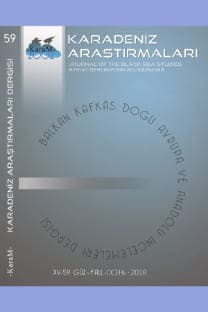YUGOSLAVYA KOMÜNİST PARTİSİNİN ULUSAL SORUN ÜZERİNE İZLEDİĞİ POLİTİKALAR (1918 -1941)
Yugoslavya Komünist Partisi, Milliyetçilik, Merkeziyetçilik, Federalizm, Balkanlar
THE POLICIES OF THE COMMUNIST PARTY OF YUGOSLAVIA ON THE NATIONAL QUESTION (1918 - 1941)
Communist Party of Yugoslavia, Nationalism, Centralism, Federalism, Balkans,
___
- KAYNAKÇA DEMİR, H. (2013). “Federalizm-Üniterizm İkileminde Sırp-Hırvat-Sloven Krallığı’nda Siyasal Yaşam (1918-1929)”, Balkan Araştırma Enstitüsü Dergisi. II/II: 91-114.
- GLIGORIJEVIĆ, B. (1989). “Stvaranje Komunističke Partije Jugoslavije”, Istorija 20. Veka, I/II: 35-49.
- GLIGORIJEVIĆ, B. (1993). “Komunisti i Jugoslovensko Pitanje”, Istorija 20. Veka, I/II: 122-128.
- GOLDSTEIN, I. (2019). “Josip Broz Tito, KPJ i Bosna i Hercegovina 1937-1943”, Međunarodna Naučna Konferencija: 75. Godišnjica Prvog Zasjedanja ZAVNOBIH-A – Povijesna Ute-meljenost Obnovljenje Državnosti Bosne i Hercegovine u 20. i 21. Stoljeću, Sarajevo: Akademija Nauka i Umjetnosti Bosne i Hercegovine. 93-113.
- JELIĆ, I. (1972). “Dolazak Josipa Broza Tita Na Čelo Komunističke Partije Jugoslavije”, Časopis za suvremenu povijest, IV/II: 27-46.
- PLETERSKI, J. (1971). Komunistička Partija Jugoslavije i Nacionalno Pitanje 1919-1941, Beog-rad: Komunist.
- MILETIĆ, R. A. (2021). “Sırplar ve Yugoslavya (1918-1991): Sırp Merkeziyetçi Paradigmasının Meşruiyeti”, Yugoslavya Tarihi 1918-1991, (ed. Hakan Demir), Ankara: Nobel. 239-270.
- NIKOLIĆ, K. (1994). “Centralni Organi Državne Uprave Kraljevine SHS o Komunističkoj Partiji Jugoslavije”, Istorija 20. Veka, C. I: 65-79.
- NIKOLIĆ, K. (1998). “Nacionalna Politika Komunistička Partije Jugoslavije Doktrina i Praksa 1919 -1945.”, Istorija 20. Veka, C. II: 65-86.
- NIKOLIĆ, K. (2011). “Mit o Komunističkom Jugoslovenstvu”, Istorija 20. Veka, C. I: 9-26.
- RADELIĆ, Z. (2021). “Yugoslavya’da Hırvatistan (1945-1991)”, Yugoslavya Tarihi 1918-1991, (ed. Hakan Demir), Ankara: Nobel. 43-59.
- RAMET, S. (2005). Tri Jugoslavije 1918.- 2005 Izgradnja Države i Izazov Legitimacije 1918. – 2005, (çev. Vesna Račković, Mirjana Vlalent) Zagreb: Golden Marketing – Tehnička Knjiga.
- REDŽIĆ, E. (1969). “KPJ i Pitanje Bosne i Hercegovine”, Prilozi, V, 19-26.
- VASIĆ, M. (1993). “Komunistička Internacionala i KPJ (1929 – 1941)”, Istorija 20. Veka, I(II): 147-154. VESOVIĆ, M. (1994). “Komunistička Štampa o Stvaranju Jugoslavije”, Istorija 20. Veka, I: 55-64.
- ISSN: 2536-5126
- Yayın Aralığı: 4
- Başlangıç: 2004
- Yayıncı: Osman Karatay
AZİZ (SVETİ/SAINT) SAVA CEMİYETİ (1886-1891)
UMRÂN TEORİSİ BAĞLAMINDA OĞUZ KAĞAN DESTANI VE DEDE KORKUT HİKÂYELERİ
ORDU/FATSA YAPRAKLI MEZARLIĞI VE TARİHİ MEZAR TAŞLARI
XVIII. YÜZYILDA ÖNEMLİ BİR ASKERİ DENİZ ÜSSÜ (SİNOP LİMANI)
ABBÂSÎ SARAYINDA ROL ALAN HEKİMLER: BUHTÎŞÛ‘ AİLESİ VE TIP TARİHİ AÇISINDAN ÖNEMİ
UKRAYNA-RUSYA SAVAŞI’NI REALİST VE SOSYAL İNŞACI (KONSTRÜKTİVİST) TEORİK ÇERÇEVEDE ANALİZ ETMEK
AFGANİSTAN’DA YAŞANAN İŞGALLERİN SEBEPLERİ VE NEDEN OLDUĞU ZORUNLU GÖÇ SÜRECİ
YUGOSLAVYA KOMÜNİST PARTİSİNİN ULUSAL SORUN ÜZERİNE İZLEDİĞİ POLİTİKALAR (1918 -1941)
